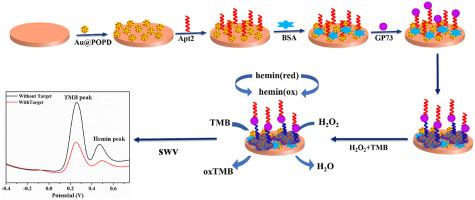Analytica Chimica Acta ( IF 5.7 ) Pub Date : 2022-06-20 , DOI: 10.1016/j.aca.2022.340102 Guiyin Li 1 , Min Chen 2 , Bo Wang 2 , Chaoxian Wang 2 , Guanxiong Wu 2 , Jintao Liang 2 , Zhide Zhou 2

|
Golgi protein 73 (GP73) is a new type of marker that can specifically detect hepatocellular carcinoma (HCC). Herein, a dual-signal sandwich-type electrochemical aptasensor for GP73 determination was constructed on the basis of hemin-reduced graphene oxide-manganese oxide (H-rGO-Mn3O4) nanozymes. Gold@poly(o-phenylenediamine) (Au@POPD) nanohybrids with a large specific surface area and conductance were co-electro-deposited onto a screen-printed electrode (SPE) surface to immobilize GP73 capture aptamer 2 (Apt2). H-rGO-Mn3O4 nanozymes were used not only to immobilize amino functionalised GP73 aptamer 1 (Apt1) as the detection probe, but also to serve as an in-situ redox signal indicator because of the redox reaction of Hemin (Fe(Ш)/Hemin(Fe(II)). In addition, given their excellent peroxidase-like activity, H-rGO-Mn3O4 nanozymes can catalyse the decomposition of H2O2 and oxidation of substrate (3,3′,5,5′-tetramethylbenzidine, TMB) to oxTMB, which is used as another redox signal. In the presence of the target GP73, the two aptamers specifically bind to the target, thereby affecting two electrochemical signals. Under optimal conditions, the dual-signal sandwich-type electrochemical aptasensor had a salient analytical performance. The two electrochemical redox signals linearly increase with the logarithm of the GP73 concentration in the range of 0.01–100.0 ng/mL with the limit of detection (LOD) of 0.0071 ng/mL and sensitivity of 2.441 μA/μM/cm2. Moreover, the recovery of human serum samples ranged from 98.66% to 121.11%. Furthermore, the two redox signals can simultaneously corroborate each other, thereby preventing missed diagnosis and misdiagnosis. All the results can provide new insights into the clinically effective determination of HCC.
中文翻译:

基于 H-rGO-Mn3O4 纳米酶的双信号夹心型适体传感器用于超灵敏高尔基蛋白 73 测定
高尔基体蛋白73(GP73)是一种新型的可特异性检测肝细胞癌(HCC)的标志物。在此,基于血红素还原的氧化石墨烯-氧化锰(H-rGO-Mn 3 O 4)纳米酶构建了用于GP73测定的双信号夹心型电化学适体传感器。将具有大比表面积和电导的Gold@poly( o -phenylenediamine) (Au@POPD) 纳米杂化物共电沉积到丝网印刷电极 (SPE) 表面以固定 GP73 捕获适体 2 (Apt2)。H-rGO-Mn 3 O 4纳米酶不仅用于固定氨基功能化的 GP73 适体 1 (Apt1) 作为检测探针,而且由于 Hemin (Fe(Ш)/Hemin(Fe(II )). 此外,由于其优异的类过氧化物酶活性,H-rGO-Mn 3 O 4纳米酶可以催化 H 2 O 2的分解和底物(3,3',5,5'-四甲基联苯胺,TMB)氧化成oxTMB,用作另一个氧化还原信号。在目标 GP73 存在的情况下,两个适体与目标特异性结合,从而影响两个电化学信号。在最佳条件下,双信号夹心型电化学适体传感器具有显着的分析性能。两个电化学氧化还原信号在 0.01-100.0 ng/mL 范围内随 GP73 浓度的对数线性增加,检测限 (LOD) 为 0.0071 ng/mL,灵敏度为 2.441 μA/μM/cm 2. 此外,人血清样品的回收率在 98.66% 到 121.11% 之间。此外,两个氧化还原信号可以同时相互印证,从而防止漏诊和误诊。所有结果都可以为HCC的临床有效测定提供新的见解。









































 京公网安备 11010802027423号
京公网安备 11010802027423号